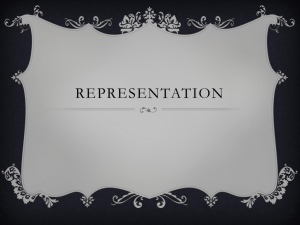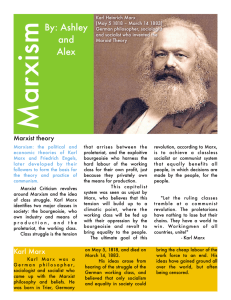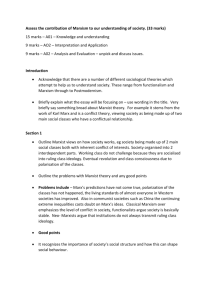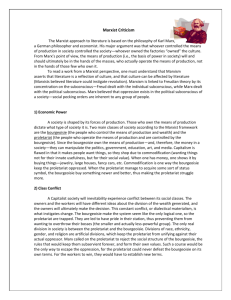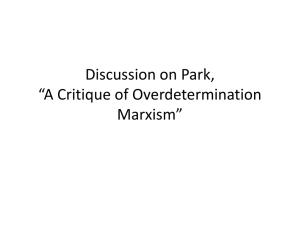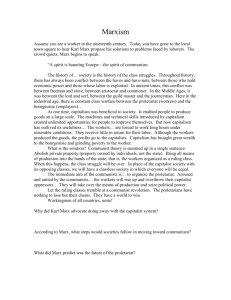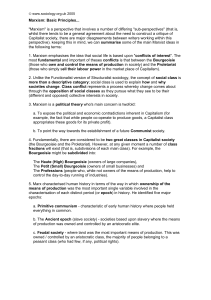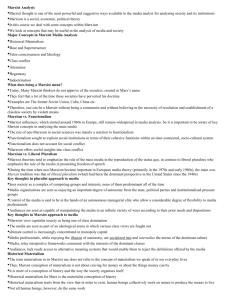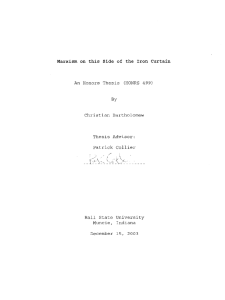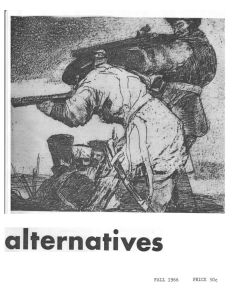Marxist Literary Theory: Definitions & Concepts
advertisement
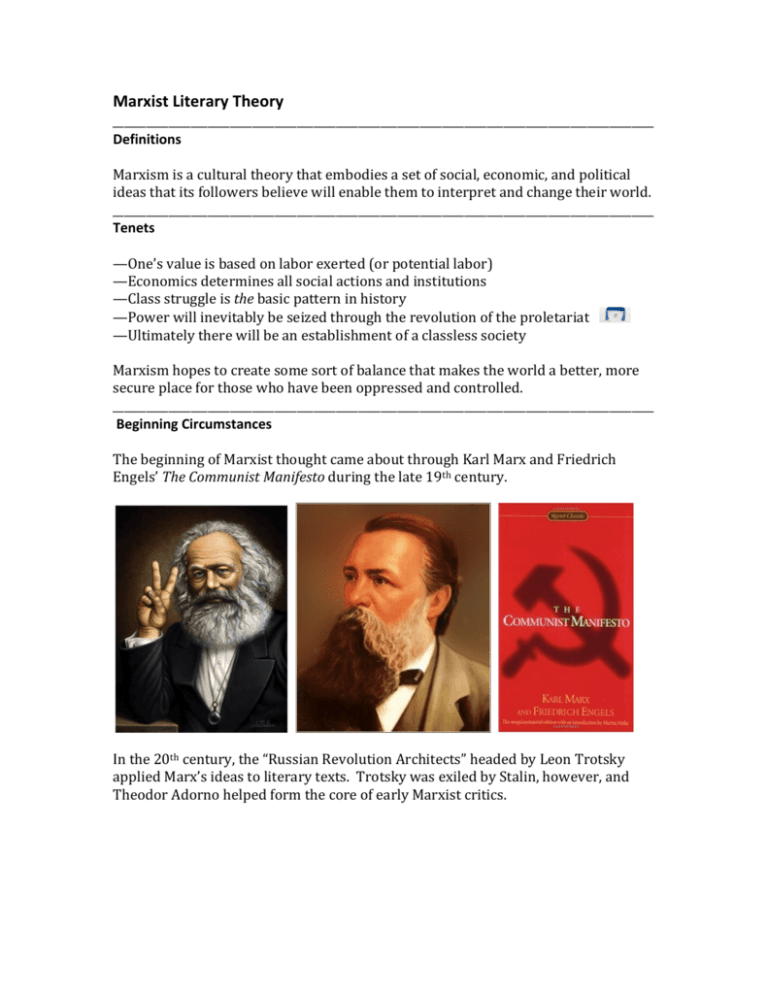
Marxist Literary Theory _________________________________________________________________________________________________ Definitions Marxism is a cultural theory that embodies a set of social, economic, and political ideas that its followers believe will enable them to interpret and change their world. _________________________________________________________________________________________________ Tenets —One’s value is based on labor exerted (or potential labor) —Economics determines all social actions and institutions —Class struggle is the basic pattern in history —Power will inevitably be seized through the revolution of the proletariat —Ultimately there will be an establishment of a classless society Marxism hopes to create some sort of balance that makes the world a better, more secure place for those who have been oppressed and controlled. _________________________________________________________________________________________________ Beginning Circumstances The beginning of Marxist thought came about through Karl Marx and Friedrich Engels’ The Communist Manifesto during the late 19th century. In the 20th century, the “Russian Revolution Architects” headed by Leon Trotsky applied Marx’s ideas to literary texts. Trotsky was exiled by Stalin, however, and Theodor Adorno helped form the core of early Marxist critics. The Frankfurt School then attempted to reconstruct the theory to enable it to withstand totalitarian corruption. The criticism reached its peak during times of economic tragedy and, consequently, following the Great Depression, faded away. Marxism then resurfaced again years later in the 1960s during the time of politically tumultuous events such as the Vietnam War and the Cuban Missile Crisis. Today the criticism is extremely varied; there is no set definition of a Marxist critic. _________________________________________________________________________________________________ Strengths þ It has the ability to adapt to a changing intellectual climate. þ It approaches the reality of life (not idealistic), and values circumstances (how events influence society). þ It has a varied and versatile approach, thus an all-­‐encompassing critical method. þ It seeks to identify disguised political and social means of oppression by means of pulling out textual clues and symbols (uncover hidden textual elements). _________________________________________________________________________________________________ Weaknesses ☐ Its intensity of views are often confused with moral issues. ☐ It also deals excessively with economic systems, which leads to the possibility of missing other important elements. ☐ It can at times be contradictory with values that only exist in the material world. ☐ Like other theories, it can be formulaic at times, sometimes going to extremes to make things fit. _________________________________________________________________________________________________ Classical (Vulgar) Marxism (1920s – 1930s) Reflection Theory (Georg Lukács) (pronounced “loo-­‐cotch,” like “watch”) This theory shows that class conflicts and worker struggles are so deeply ingrained in societies that they are reflected in literature, going back to the stance that the superstructure mirrors the base. Superstructure (law, politics, art, morality, religion) is a reflection/outgrowth/ extension of base (means of production: farming, industry, craft). Regarded as the path humanity must eventually take. The reference point for all texts was Marx’s Historical Theory, encompassing four distinct historical epochs: 1. Feudalism – Aristocrats v. Peasants (large lower class). —Emerging bourgeois demands change in ownership of capital. 2. Capitalism – Bourgeois (middle class) v. Proletariat (working class) —Bourgeois controls mode of production. —Proletariat consists of contract laborers. —Bourgeois controls proletariat through product regulation and by imposed ideologies. Eventually, the result is a revolt followed by the replacement of power to the hands of government. 3. Socialism – State controls modes of distribution, given out on the basis of need. 4. Communism – “Worker’s Paradise,” common pool of capital and the reception of the full value of labor. FEUDALISM: You have two cows. Your lord takes some of the milk. CAPITALISM: You have two cows. You sell one and buy a bull. SOCIALISM: You have two cows. The government takes them and puts them in a barn with everyone else’s cows. You have to take care of all the cows. The government gives you as much milk as you need. PURE COMMUNISM: You have two cows. Your neighbors help you take care of them, and you all share the milk. APPLIED COMMUNISM: You have two cows. You have to take care of them, but the government takes all the milk. Reflection Theory attempted to see Marxist theory in action. Production Theory (Walter Benjamin) Focuses on the text as a product of economic and social conditions. Market constraints (consumer appeal, money, interest, etc.) dictate what is written. This theory was too simplistic with its existence of only one source for literature influence. Contradiction: By portraying literature as a purely influenced product of the base (what regulates consumption and distribution of goods and services), classical Marxism implies that literature is ultimately a tool of the upper class and possesses no independent value. The concept of value’s existence hinging solely on the material world led to the idea that writing was insignificant. Post-­‐Althusser Marxism (Louis Althusser, 1960s) Sought to revise contradictions by contending that a base can’t influence the superstructure without being influenced itself. Texts have an identity of their own and are “functional factors” in the “economic web,” not just reflections of the economic base. _________________________________________________________________________________________________ Major Works Louis Althusser – Lenin and Philosophy / For Marx / Reading Capital Georg Lukács – The Historical Novel / History and Class Consciousness Karl Marx – Contribution to the Critique of Political Economy / The Communist Manifesto / Das Kapital Leon Trotsky – Literature and Revolution _________________________________________________________________________________________________ Associated Terms • Base: the methods of production (farming, factories, craftsmanship, etc.) • Superstructure: emerges from the factors of the base into such things as law, politics, jurisprudence, art, morality, and religion (“control systems”) • Reflectionism: a theory that the superstructure of a society mirrors its economic base and, by extension, that a text reflects the society that produced it _________________________________ • Bourgeoisie: those who own property and control the means of production • Proletariat: the majority of the global population who live in substandard conditions who have always performed the manual labor that fills the coffers of the rich • FYI: “Bourgeois” = adjective for “middle class” or “materialism”; “Bourgeoisie” = noun for the middle class itself (and its accompanying materialistic values) Production Theory: the ability of literature and art to change the base of society • Reflection Theory: a text directly reflects a society’s consciousness • Vulgar Marxism: another name for reflectionism; those who practice it try to determine the true and complete nature of a given society _________________________________ • Classism: an ideology that equates one’s values as a human being with the social class to which one belongs • Commodification: the attitude of valuing things not for their utility but for their power to impress others or for their resale possibilities • Hegemony: the assumptions, values and meanings that shape meaning and define reality for the majority of people in a given culture • Ideology: a belief system or a product of cultural conditioning _________________________________ • • • • • Conspicuous Consumption: the obvious acquisition of things only for their sign value and/or exchange value Exchange Value: an assessment of the worth of something based on what it can be traded or sold for Sign Value: an assessment of something based on how impressive it makes a person look Use Value: an appraisal of something based on what it can do $85 @ Dillard’s _________________________________ • Dialectical Criticism: all critics must be aware of their own ideology when analyzing a text, possessing dialectical self-­‐awareness • Dialectical Materialism: (a core belief of Marxism) our ideas and concepts about ourselves are fashioned in everyday discourse in the language of real life and are not derived from any spiritual reality. The basis of reality is material, no spiritual reality exists • False Consciousness: when a cultural conditioning leads the people to accept a system that is unfavorable for them without protest or questioning; to accept the logical way for things to be _________________________________ • Imperialism: the military, economic, and/or cultural domination of one nation by another for the financial benefit of the dominant nation with little or no concern for the welfare of the dominated Interpellation: the process by which the subordinate class is manipulated to accept the ideology of the dominant one • Material Circumstances: the economic conditions underlying the society • Political Unconscious: the repressed conditions of exploitations and oppression • Rugged Individualism: an ideology that keeps the focus on “me” instead of on “us,” thus working against class action and giving us the illusion that we make our own decisions and are not influenced by ideology • Weltanshauung: the worldview of the author • Worker’s Paradise: when society reaches the goal of becoming a communist society from a capitalist one _________________________________________________________________________________________________ Marxist Critics . . . —focus on oppressive situations that exist in literature as a means of seeing historical and economic forces at work. —look for ideas literature might offer intended to spark a revolutionary moment within a nation, specifically for the proletariat to overcome the bourgeoisie. —identify operative ideologies by looking at the many factors that could be overcome to help a dream government arise: the presence of oppression how/why/when the working class isn’t progressing to what degree the bourgeoisie’s ideology controls/oppresses workers • —highlight elements of society most affected by such oppression leading to action, revolution, and social change. —seek to uncover use of symbols, imagery, and metaphor in texts, and any lurking realities associated with them. —identify the author’s weltanshauung, or world view, which helps in understanding the government established at the time the writer lived and wrote—and whether or not people (or just the author) really supported it. _________________________________________________________________________________________________ Questions – Does the text criticize the emptiness of life in a bourgeois society? – How is the fate of the individual determined by societal forces? – Are the characters from all social levels equally sketched? – Is there a rejection of capitalism? – How completely/accurately is society portrayed? – Are the identities of conflicting forces acknowledged? – Are solutions/actions forced? – Are all social classes represented? – Does the text depict values of each class? – What values allow for action/change? – Are problems individual or collective? – What class structures are established in the text? – Which characters or groups control the economic means of production? – What class conflicts are exhibited? – Which characters are oppressed, and to what social classes do they belong? – Which characters are the oppressors? – What is the hegemony established in the text? – What social conflicts are ignored? – Who represents the status quo? – Does the work suggest a solution to a society’s class conflicts? – What is the dominant ideology revealed in the text? – Did the main character support or defy the dominant ideology? – Is the narrator a member of the bourgeoisie or the proletariat? – Whose story gets told in the text? Whose story does not get told? – When and where was the text published? – Is the author’s stated intention for writing the work known or public? – What were the economic issues surrounding the publication of the text? – Who are the powerful people in the society depicted in the text? Who are the powerless people? Are they depicted with equal attention? – Why do the powerful have that power? Why is it denied to others? – Is there evidence of class conflict and struggle? – Is there evidence of repression and manipulation of workers by owners? – Is there evidence of alienation and fragmentation? – Does the bourgeoisie in the text, either consciously or unconsciously, routinely repress and manipulate less powerful groups? If so, what are the tools they use? News? Media? Religion? Literature? – What does the setting tell you about the distribution of power and wealth? – Is there evidence of conspicuous consumption? – Does the society that is depicted value things for their usefulness, for their potential resale or trade, or for their power to convey social status? – Is there evidence that the text itself is a product of the culture in which it originated? – Does this text make you aware of your own acceptance on any social, economic, or political practices that involve control or oppression of others? – What are the values of the author’s time and place? Where are they reflected in the text? – What biographical elements of the author’s life can account for his ideology? Where are they reflected in the text? – What are the socioeconomic conditions of the writer’s culture? Where are they reflected in the text? – Who read the work when it was first published? How it was initially received? – Does the work reinforce (intentionally or not) capitalist, imperialist, or other classist values? – How might the work be seen as a critique of capitalism, imperialism, or classism? – In what ways does the text reveal, and invite to condemn, oppressive socioeconomic forces? – Does the work in some ways support a Marxist agenda but in other ways (perhaps unintentionally) support a capitalist, imperialist, or classist agenda? Is the work ideologically conflicted? – How does the literary work reflect (intentionally or not) the socioeconomic conditions of the time in which it was written and/or the time in which it is set, and what do those conditions reveal about the history of class struggle?
